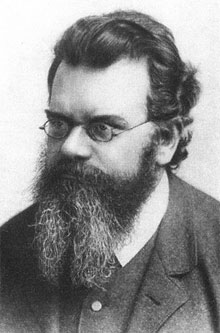
Boltzmann
Ludwig Eduard Boltzmann (February 20, 1844 – September 5, 1906) was, with James Clerk Maxwell, the founding father of statistical mechanics. He was co-discoverer of the Maxwell-Boltzmann distribution and the originator of the H-theorem, which purported to show how irreversibility in the thermodynamic sense could be derived from an underlying deterministic (and time-reversible) mechanics. He developed the combinatorial methods for the calculation of the statistical mechanical entropy that when applied, by Planck, to the equilibrium distribution of matter and radiation (black-body radiation) provided the key to the discovery of the quantum of action (Planck’s constant). The equation S=k logW relating the entropy S to the logarithm of phase-space volume W – which Boltzmann also identified as a probability -- is due to Boltzmann; k is known as Boltzmann’s constant.
The H-theorem was only one of many attempts to reconcile the observed irreversibility of thermodynamic processes with an underlying deterministic, and reversible, microphysics. Boltzmann’s central idea was that impacts among large numbers of microscopic particles is an essentially randomising process, and that those regions of phase space in which these motions are disordered are much larger – are more probable – than those in which they are ordered. But Boltzmann had several different conceptions of probability that he did not clearly distinguish in his writings.
Objections by Loschmidt and Zermello to the H-theorem and other attempts to derive irreversible from reversible behaviour eventually prompted Boltzmann to the conjecture that the observed universe arose as a spontaneous fluctuation away from equilibrium to a low entropy state, from which it is slowly returning to equilibrium. This solution is similar to the one, prevalent today and given a Big-Bang cosmology, that the universe began in a low entropy state. Whether and in what sense such a state is enormously special – and hence itself stands in need of explanation – remains a matter of controversy (the low-entropy problem). Meanwhile Boltzmann’s rational for invoking a statistical fluctuation as a rational for the observed time asymmetry yields the problem of ‘Boltzmann brains’ – that if the objective is to account for our actual perceptions, it is far more likely that human brains arose as spontaneous fluctuations with memories of a low-entropy environment, than that the low-entropy environment was produced as well. This too remains a matter of controversy.
Boltzmann was born and spent his early life in Vienna where he became privatdozent in 1867. At the age of 25 he became the Professor of Mathematical Physics at the University of Graz. He eventually returned to Vienna in 1902 where he remained until his death, at his own hand, in 1907. Boltzmann had long suffered from bouts of depression, but he had also been involved in a long and acrimonious debate over the reality of atoms and molecules. Ernst Mach, professor of philosophy at the University of Vienna, was hostile to Boltzmann’s statistical mechanics as the basis and extension of thermodynamics into the non-equilibrium domain, and in a series of influential critiques of Newton’s theory of space and time as well as atomism argued against appeal to hypothetical and unobservable entities in physics. Boltzmann undertook to study and give lectures in philosophy at Vienna in an attempt to counter the influence of Mach and other of the so-called energeticists, but considered himself to have failed in the endeavour.
Links
Stanford Encyclopedia of Philosophy >
